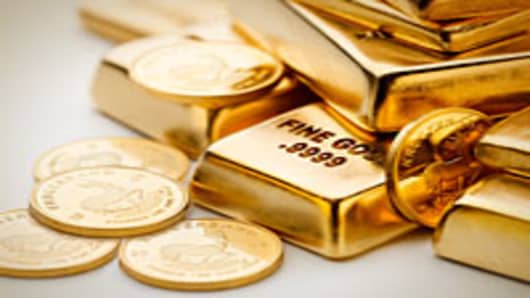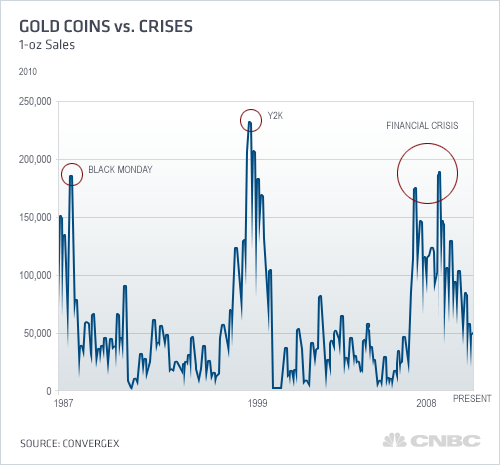Sliding gold coin sales show that retail demand for the actual metal is clearly fading, but dealers and analysts say it is not because investors are less concerned about the financial turmoil around the globe. There's just not the same fervor for the precious metal as in recent years.
"This is the first time in our economic history that we have a situation where there is such tremendous economic uncertainty and global fear when gold has not skyrocketed in tandem," said gold dealer Lee Rosenbloom, owner of Plaza 57 Appraisals and Plaza Collectibles in New York.
COMEX gold futures have declined 9.5 percent, nearly $200, from the 2012 peak near $1,800 an ounce, and prices over the past 12 months are basically flat. As for the physical metal, declining sales in U.S. gold coins — a real-time proxy for retail investment demand — along with a somewhat stagnant gold futures price indicate the frenzy over gold has calmed, but it's certainly not been crushed.
Sales of gold coins at the U.S. Mint plunged to about 30,000 for one-ounce gold coins in July — that's less than half the number sold in the same month last year and more than six times fewer than at the peak of the financial crisis in 2008.
"Coin sales are price sensitive, but there's a bit of a lag effect," explained HSBC precious metals analyst James Steel. Gold prices rose in January and February to the highs of the year and coin demand dropped a few months later due to those high prices, he said.
But "the decline in retail coin sales does not necessarily herald a bear market," noted Steel.
ConvergEx Group's chief market strategist Nicholas Colas agrees slowing demand for gold coins is not necessarily a negative sign. "Demand which was in fact probably too high in 2008 and 2009 because of worries of the financial crisis has simmered down to a more sustainable rate, reflecting a more structural level of demand that is sustainable and ongoing and one that is healthier ultimately for the gold markets," Colas says.
The gold market has witnessed this cycle before. Gold coin sales historically spike in times of uncertainty — most recently during the 2008-2009 financial crisis, the 1999 Y2K scare, and in October 1987, after Black Monday. Once the initial cause of panic levels off, sales return to more normalized levels, Colas says.
Yet even without a financial crisis, demand for gold won't just disappear, he said, since it fulfills a role no other commodity or financial asset provides: low correlation to and diversification from other markets.
And for retail investors, it's not all about crises or fear. Coin buyers, unlike institutional buyers, aren't usually seeking a "safe-haven" to protect large portfolios, said RBC Capital Markets' precious metals strategist George Gero. Also, he added, "as the economic recovery has weakened, retail investors have had less disposable income to purchase coins."
But well-capitalized investors may begin to fill the void.
Coin dealers say their clientele is changing. "Previously, we had the general public purchasing gold," Rosenbloom said. "Now our coins are going to less people, however, more sophisticated, big-money investors and buyers."
Steelcontends physical demand for gold will remain slow and steady. He says the gold market has stabilized, consistently holding above $1,525 an ounce so far this year. "Retail interest from gold buyers may have faded, but has by no means evaporated altogether," he says.
As the U.S. presidential election approaches, and if U.S. fiscal problems are front-and-center in the markets once again, Steel says further uncertainty could stimulate gold coin sales. So the precious metals craze may have slowed down, but sliding coin sales don't mean the gold rush is over.
-By CNBC's Sharon Epperson
Follow Sharon on Twitter: @sharon_epperson




